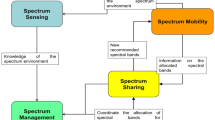Abstract
The cognitive radio networks (CRNs) can enhance the utilization of spectrum by enabling secondary users (SUs) towards accessing the unoccupied channels dynamically by the PUs (primary users). The scheme of spectrum access in terms of augmenting the performance of user has attained more significance. However, the channel scheduling and utilization is the critical objective to realize the spectrum band sensing by secondary users as optimal robust. Regard to this, the contemporary research focused to rendezvous the transmission load and radio frequencies available. This manuscript have portrayed a novel method of “Ideal Frequency Rendezvousing for Multiuser Communication (IFRMC) over Cognitive Radio Network”. The competence of the IFRMC is, that schedules white-spaces (idle time between two consecutive schedules of the corresponding frequencies), alongside, scheduling available frequencies, and rendezvousing the chunks of the transmission load and the available radio frequencies. The experimental study that carried on cognitive radio network simulations stated the performance of the proposed model that compared to the other contemporary models.




Similar content being viewed by others
References
Ali, A., Kwak, K. S., Tran, N. H., Han, Z., Niyato, D., Zeshan, F., et al. (2018). RaptorQ-based efficient multimedia transmission over cooperative cellular cognitive radio networks. IEEE Transactions on Vehicular Technology, 67(8), 7275–7289.
Amjad, M., Rehmani, M. H., & Mao, S. (2018). Wireless multimedia cognitive radio networks: A comprehensive survey. IEEE Communications Surveys & Tutorials., 20(2), 1056–1103.
Anand, S., Hong, K., Sengupta, S., & Chandramouli, R. (2011). Is channel fragmentation/bonding in IEEE 802.22 networks secure? In: 2011 IEEE international conference on communications (ICC) 2011 Jun 5 (pp. 1–5). IEEE.
Balapuwaduge, I. A., Jiao, L., Pla, V., & Li, F. Y. (2013). Channel assembling with priority-based queues in cognitive radio networks: Strategies and performance evaluation. IEEE Transactions on Wireless Communications, 13(2), 630–645.
Bukhari, S. H., Rehmani, M. H., & Siraj, S. (2015). A survey of channel bonding for wireless networks and guidelines of channel bonding for futuristic cognitive radio sensor networks. IEEE Communications Surveys & Tutorials, 18(2), 924–948.
Chaoub, A., Ennaoui, F. Z., & Ibn-Elhaj, E. (2019). Reliable rate-adaptive video transmission over cognitive cellular networks using multiple description scalable coding. Telecommunication Systems, 71(3), 321–338.
Das, D., & Abouzeid, A. A. (2016). Co-operative caching in dynamic shared spectrum networks. IEEE Transactions on Wireless Communications, 15(7), 5060–5075.
Debroy, S., De, S., & Chatterjee, M. (2014). Contention based multichannel MAC protocol for distributed cognitive radio networks. IEEE Transactions on Mobile Computing, 13(12), 2749–2762.
Fakhrudeen, A., & Alani, O. Y. (2017). Comprehensive survey on quality of service provisioning approaches in cognitive radio networks: Part one. International Journal of Wireless Information Networks, 24(4), 356–388.
Haykin, S. (2005). Cognitive radio: Brain-empowered wireless communications. IEEE Journal on Selected Areas in Communications, 23(2), 201–220.
Hsu, A. C., Wei, D. S., & Kuo, C. C. (2007). A cognitive MAC protocol using statistical channel allocation for wireless ad-hoc networks. In: 2007 IEEE wireless communications and networking conference 2007 Mar 11 (pp. 105–110). IEEE.
Jeon, W. S., Han, J. A., & Jeong, D. G. (2012). A novel MAC scheme for multichannel cognitive radio ad hoc networks. IEEE Transactions on Mobile Computing, 11(6), 922–934.
Li, X., Liu, H., Roy, S., Zhang, J., Zhang, P., & Ghosh, C. (2012). Throughput analysis for a multi-user, multi-channel ALOHA cognitive radio system. IEEE Transactions on Wireless Communications, 11(11), 3900–3909.
Li, J., Zhao, H., Zhang, S., Hafid, A. S., Niyato, D., & Wei, J. (2019). Cross-layer analysis and optimization on access delay in channel-hopping-based distributed cognitive radio networks. IEEE Transactions on Communications, 67(7), 4654–4668.
Mitola, J., III, & Maguire, G. Q., Jr. (1999). Cognitive radio: Making software radios more personal. IEEE Personal Communications, 6(4), 13–18.
Moon, M. S., & Gulane, V. A. (2016). Preferable channel list based channel selection in cognitive radio network. IRACST: International Journal of Computer Networks and Wireless Communications (IJCNWC), ISSN. 2016 Mar (pp. 2250–3501).
Rehmani, M. H., Lohier, S., & Rachedi, A. (2012). Channel bonding in cognitive radio wireless sensor networks. In: 2012 international conference on selected topics in mobile and wireless networking 2012 Jul 2 (pp. 72–76). IEEE.
Ren, P., Wang, Y., & Du, Q. (2013). CAD-MAC: A channel-aggregation diversity based MAC protocol for spectrum and energy efficient cognitive ad hoc networks. IEEE Journal on Selected Areas in Communications, 32(2), 237–250.
Robinson, G. O. (1978). The Federal Communications Commission: An essay on regulatory watchdogs. Virginia Law Review, 1, 169–262.
Tragos, E. Z., & Zeadally, S. (2013). Spectrum assignment in cognitive radio networks: A comprehensive survey. IEEE.
Ukey, A. S. A., & Chawla, M. (2019). On maximizing blind rendezvous probability in cognitive radio ad hoc networks. Optical and wireless technologies (pp. 149–159). Singapore: Springer.
Wang, K., et al. (2019). On cooperative channel rendezvous in cognitive radio networks. IEEE Access, 7, 57500–57515.
Author information
Authors and Affiliations
Corresponding author
Additional information
Publisher's Note
Springer Nature remains neutral with regard to jurisdictional claims in published maps and institutional affiliations.
Rights and permissions
About this article
Cite this article
Suneetha, C., Srinivasa Rao, S. & Ramesh, K.S. Ideal frequency rendezvousing for multiuser communication (IFRMC) over cognitive radio network. Int J Speech Technol 23, 537–547 (2020). https://doi.org/10.1007/s10772-020-09741-8
Received:
Accepted:
Published:
Issue Date:
DOI: https://doi.org/10.1007/s10772-020-09741-8




